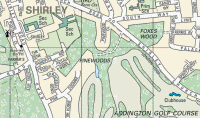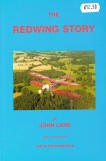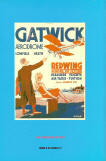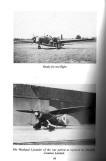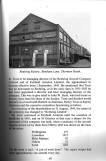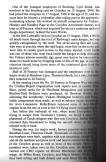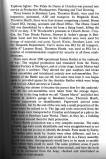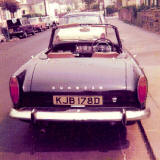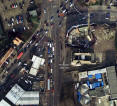|
Ernie Clarke (JRCS 1935-39) recalls more aspects of pre-War school life... |
|
Ernest Clarke, February 2007 Email |
|
Geoffrey Downer (JRGS 1962-69) reveals his illustrious career in Holland ... |
|
Geoffrey C. van Beek, Rotterdam, Holland, February 2007 Email. |
|
Mel Lambert (JRGS 1959-65) follows an Internet thread to Addington Golf Club... |
|
It's sometimes odd how you can be trawling one area
of the Internet and come across something remotely connected, but
even more interesting. Mel Lambert, February 2007 Email Bob Dench (JRGS 1961-66) adds: The Alumni might be interested to know that P. G. Woodhouse had so much trouble with getting stuck in the sixth hole bunker - it's in a chasm in front of the green, shown above left - that his business cards stated: "PG Woodhouse, The bunker, Sixth Hole, The Addington Golf Club." |
|
Paul Graham (JRGS 1959-66) recalls former teacher Arthur Charles Warne... |
||||
Arthur Charles Warne died on 16th
November, 2005, aged 77. He had lived in Stevenage for 42 years, and
been a member of the Rotary Club of Stevenage for over 25 years. The
following is based on a tribute to his life given by Ian Hamilton at
his funeral service on 25th November, 2005, at St Nicholas Church
Stevenage, Hertfordshire.
He taught at John Ruskin GS from before 1955, leaving in December
1959 to go to Malory School, SE London, before arriving in
Stevenage in 1963 as the newly appointed head teacher of Chells
Secondary School. He then moved to the Priory in Hitchin in a more
administrative role, and then onto St. Audrey’s in Hatfield, before he
retired after 40 years in education. Paul Graham, January 2007 Email
Brian (Bone) V. Thorogood
(JRGS 1951-56) adds: It was at the start of our second year in
September 1952 that a new, young, good-looking teacher arrived on the
scene in Mr. Warne, who took junior classes for French and some Latin.
He also occasionally took PT. |
|
Mike Etheridge (JRGS 1963-65) discovers origins of Redwing aircraft factory... |
||||||
|
I acquired an excellent book at Croydon airport the other week and thought that The Alumni might be interested in a couple of scanned pages. The book, entitled The Redwing Story, and written by John Lane, is published by Mrs. Philis Lane, 23 Avenue Court, The Avenue, Tadworth, Surrey KT20 5BG. Click on any thumbnail to view a full-size image. UK price is £12.50. Contents and layout design ©2006 John Lane.
Although I was aware for a number of years that there was an biplane aircraft built in the 1930s called The Redwing, I was never sure it had any association with the Redwing factory in Bensham Road/Lucerne Road, Thornton Heath (demolished 1985/6). I also did not know that the company used Gatwick airport (only an airstrip in the 1930s) prior to the expansion and commercialisation of the site.
It a was a standing joke
in the family that my Dad moved the family from the Waddon area to
Lucerne Road - he worked in the Lab at Waddon Isolation hospital at
the time - to avoid the bombing that had first occured on the
Croydon airport site when the Germans hit the Bourjois perfume
factory. Not long after the family had moved Dad found out that the
factory at the top of the road was producing aircraft parts and was
obviously a prime target! The Lucerne Road houses were eventually
shattered by a V1 bomb that demolished two Victorian houses in
Brigstock Road where Trumble Gardens was created. Mike Etheridge, January 2007 Email. Ernie Clarke (JRGS 1935-39) adds: I was most intrigued by Mike's material on the Redwing Factory. I left Thornton Heath in 1949 (and was absent on war service from 1942-47), but I do have recollections of the factory as we lived in Geneva Road - a mere stone's throw. Memories can be a little hazy for an 82-year-old, but I think we all knew that they were producing aircraft parts. I also remember the first German raid on Croydon aerodrome. But that's about it! Many thanks. Alan Durr (JRGS 1963-65) adds: Mike's recollections are absolutely fascinating! I knew nothing of this - Trumble Gardens, red wing planes, V1s aimed at The Etheridges. And as for the picture of the Redwing factory - so evocative of the time when walking past it on the way to school all those years ago.
Peter Oxlade (JRGS 1940-44)
adds: I loved Mike's story about Redwings and remember that factory
in Bensham Lane. I moved to 39 Lucerne Road in 1955 and am wondering if
Mike or his family were there then.
Peter Oxlade replies: Sorry, but I was not into cars in those
days. But you are quite right; it was a very good community to live in
and a far cry from what it is today. Ernie Clarke replies: How could I forget Mr. Chinnock? The first thing I see every morning is a small bedside table made of oak and assiduously polished under his watchful eye. And an oak fire screen is with one of my sons. And, of course, I remember Mr. Cracknell. (Plus one or two more who will appear when I get round to my "memoirs"!) ML adds: Sadly, George Chinnock, who joined the school with the founding teachers in 1920, passed away in February 1955, aged 61. Mr. Myers served as Second Master/Deputy Head until 1951 when he moved, after 26 years on the JRGS staff, to take a headmaster position at the newly opened John Newnham Secondary School, Selsdon. William Cracknell was probably the longest serving JRGS master, retiring in 1976 after 40 years of continuous service with the school; sadly he passed away in May 2000, aged 88. (John Rowlands, who joined the JRGS staff in 1966, and who is still teaching at the Sixth Form College, looks set to break that record.)
Terence Morris (JRGS 1942-50)
adds: Reading these entries about the Redwing aircraft factory in
Bensham Lane (which I used to cycle past on my way to School from
Thornton Heath) I noted an entry from Ernie Clarke about the air raid on
Croydon aerodrome in August 1940. I recall waiting for the 194 bus in
West Wickham, where I had spent the day with an aunt. As we stood at the
bus stop it was possible to see a huge pall of smoke rising in the air,
which we later learned was coming from the burning buildings all along
Purley Way.
|
|
Ernie Clarke (JRGS 1935-39) recalls aspects of pre-War life at the school... |
|
I didn't even take the School Certificate because, of course, it was the year war broke out and my father insisted
on mother and I remaining in Leicestershire where we were holidaying
during the summer. War was looming and, of course, London would be
obliterated within days! Ernest Clarke, January 2007 Email.
ML adds: We warmly welcome Ernie to
The Alumni Society. With Norman High (JRGS 1928-33), he is
our second most senior correspondent, followed by Peter Otway (JRGS 1938-42)
and Peter Oxlade (JRGS 1940-44). |
|
David Anderson (JRGS 1964-71) uncovers some interesting maps & aerial photos... |
|
I thought the JRGS Alumni might want to
take a look at
http://www.local.live.com. There is no big software download, it's free, and you can search for your old
haunts by place Name then Map, then Aerial photo and then, best of all,
the Oblique shots. David Anderson, January 2007 Email.
ML adds: If you access the site
from outside the UK, I think your ISP automatically informs the host that you are accessing from whatever country you live in, and then
focuses on searching that territory. |
|
Archived News/Events Pages have been moved here. |
|
The content of this web site is provided for educational purposes only, and is subject to change without notice. The JRGS Alumni Society makes no representation about the accuracy, reliability, completeness or timeliness of the content of this web site, nor the results to be obtained from using any part of such content. |
Please send any messages and memorabilia to
webmaster
©2026 JRGS Alumni Society. All
Rights Reserved. Last revised:
07.12.25

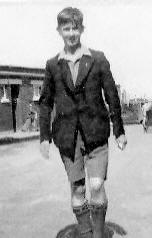 At
last I'm getting round to it! Recollections of John Ruskin Selective
Central School, Tamworth Road, Croydon - and that's me, shown left, in
1938.
At
last I'm getting round to it! Recollections of John Ruskin Selective
Central School, Tamworth Road, Croydon - and that's me, shown left, in
1938.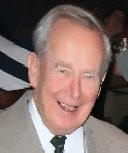
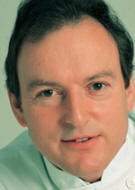 My
name is now Geoffrey C. van Beek, but I am to be found on the 1967 Class 5G
My
name is now Geoffrey C. van Beek, but I am to be found on the 1967 Class 5G
